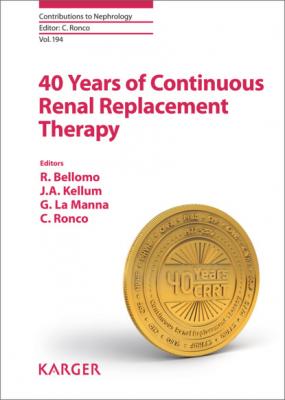ТОП просматриваемых книг сайта:
40 Years of Continuous Renal Replacement Therapy. Группа авторов
Читать онлайн.Название 40 Years of Continuous Renal Replacement Therapy
Год выпуска 0
isbn 9783318063073
Автор произведения Группа авторов
Жанр Медицина
Серия Contributions to Nephrology
Издательство Ingram
When going beyond 0.8 mg/dL over 4–6 h, citrate accumulation must always be considered.
Hypernatremia?
–Cause: high citrate flow relative to UF flow. May occur when UF flow gradually declines at unchanged citrate flow. Metabolic alkalosis is mostly present.
–Treatment: filter change if TMP >250 mm Hg, target normal sodium concentration, buffer-free solution.
Hyponatremia?
–Cause: use of substitution solutions with low sodium content. Since such solutions contain no buffer, metabolic acidosis may arise.
–Treatment: substitution with normal saline, bicarbonate-buffered solution.
Monitoring of Metabolic Variables and Coagulation Efficacy?
–At 4-h interval: measurement of Na+, K+, Cl−, ionized calcium, blood gas, (strong) anion gap calculation,
–Once daily: total calcium (to calculate calcium ratio or calcium gap), magnesium,
–Once or twice daily: creatinine, urea, phosphate,
–Monitoring intervals can be progressively prolonged in stable patients,
–Monitoring efficacy of circuit anticoagulation is necessary at the start of treatment and may be continued at the physician’s discretion thereafter. A post-filter ionized calcium level of 0.25–0.35 mmol/L (0.8–1.3 mg/dL) is targeted.
Conclusions
Vascular access and anticoagulation for CRRT have considerably evolved over the years. Dialysis catheters are preferentially placed in the RIJ vein with the tip positioned in the right atrium. Ultrasound guidance may assist in placing the catheter. Femoral vein catheterization is a valuable alternative. Future improvements in catheter “technology” and performance are awaited, in particular for use in combined extracorporeal techniques (e.g., low flow extracorporeal CO2 removal embedded in a CRRT circuit).
RCA has revolutionized anticoagulation by allowing lower circuit blood flow, causing less bleeding accidents, and creating better filter performance. However, implementing RCA requires careful monitoring, including early detection and anticipation of potential citrate-related metabolic complications. Novel citrate solutions are being developed that will allow more optimal metabolic fine-tuning.
References
1Honore PM (Editor-in-Chief): Renal replacement in critical care; in Honore PM, Joannes-Olivier O, Spapen HD, Bihorac A (eds): Textbook 269 pages. Lambert Academic Publishing release in February, 2016.
2Glazer S, Saint L, Shenoy S: How to prolong the patency of vascular access. Contrib Nephrol 2015;184:143–152.
3Granata A, D’Intini V, Bellomo R, Ronco C: Vascular access for acute extracorporeal renal replacement therapies. Contrib Nephrol 2004;142:159–177.
4Parienti JJ, Mégarbane B, Fischer MO, Lautrette A, Gazui N, Marin N, Hanouz JL, Ramakers M, Daubin C, Mira JP, Charbonneau P, du Cheyron D; Cathedia Study Group: Catheter dysfunction and dialysis performance according to vascular access among 736 critically ill adults requiring renal replacement therapy: a randomized controlled study. Crit Care Med 2010;34:1118–1125.
5Morgan D, Ho K, Murray C, Davies H, Louw J: A randomized trial of catheters of different lengths to achieve right atrium versus superior vena cava placement for continuous renal replacement therapy. Am J Kidney Dis 2012;60:272–279.
6Lameire N, Kellum JA; KDIGO AKI Guideline Work Group: Contrast-induced acute kidney injury and renal support for acute kidney injury: a KDIGO summary (part II). Crit Care 2013;17:205.
7Canaud B, Formet C, Raynal N, Amigues L, Klouche K, Leray-Moragues H, Béraud JJ: Vascular access for extracorporeal renal replacement therapy in the intensive care unit. Contrib Nephrol 2004;144:291–307.
8Parienti JJ, Thirion M, Mégarbane B, Souweine B, Ouchikhe A, Polito A, Forel JM, Marqué S, Misset B, Airapetian N, Daurel C, Mira JP, Ramakers M, du Cheyron D, Le Coutour X, Daubin C, Charbonneau P; Members of the Cathedia Study Group: Femoral vs jugular venous catheterization and risk of nosocomial events in adults requiring acute renal replacement therapy: a randomized controlled trial. JAMA 2008;299:2413–2422.
9Joannidis M, Oudemans-van Straaten HM: Clinical review: patency of the circuit in continuous renal replacement therapy. Crit Care 2007;11:218.
10Schetz M: Vascular access for HD and CRRT. Contrib Nephrol 2007;156:275–286.
11Baldwin I, Bellomo R: Relationship between blood flow, access catheter and circuit failure during CRRT: a practical review. Contrib Nephrol 2004;144:203–213.
12Parienti JJ, Deryckère S, Mégarbane B, Valette X, Seguin A, Sauneuf B, Mira JP, Souweine B, Cattoir V, Daubin C, du Cheyron D; Cathedia Study Group: Quasi-experimental study of sodium citrate locks and the risk of acute hemodialysis catheter infection among critically ill patients. Antimicrob Agents Chemother 2014;58:5666–5672.
13Mehta RL, McDonald BR, Aguilar MM, Ward DM: Regional citrate anticoagulation for continuous arteriovenous hemodialysis in critically ill patients. Kidney Int 1990;38:976–981.
14Mehta RL, McDonald BR, Ward DM: Regional citrate anticoagulation for continuous arteriovenous hemodialysis. An update after 12 months. Contrib Nephrol 1991;93:210–214.
15Jacobs R, Honoré PM, Bagshaw SM, Diltoer M, Spapen HD: Citrate formulation determines filter lifespan during continuous veno-venous hemofiltration: a prospective cohort study. Blood Purif 2015;40:194–202.
16Gainza FJ, Quintanilla N, Pijoan JI, Delgado S, Urbizu JM, Lampreabe I: Role of prostacyclin (epoprostenol) as anticoagulant in continuous renal replacement therapies: efficacy, security and cost analysis. J Nephrol 2006;19:648–655.
17Jacobs R, Honore PM, Hendrickx I, Spapen HD: Regional citrate anticoagulation for continuous renal replacement therapy: all citrates are not created equal! Blood Purif 2016;42:219–220.
18Oudemans-van Straaten HM, Ostermann M: Bench-to-bedside review: citrate for continuous renal replacement therapy, from science to practice. Crit Care 2012;16:249.
19Jacobs R, Honore PM, Spapen HD: Some metabolic issues should not be neglected when using citrate for continuous renal replacement therapy! Crit Care 2015;19:50.

